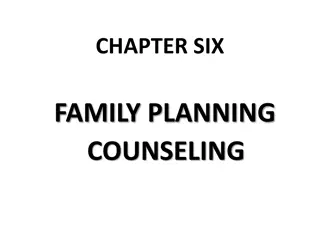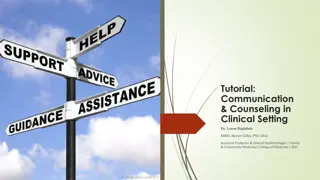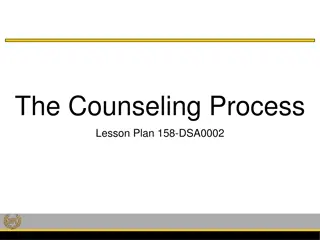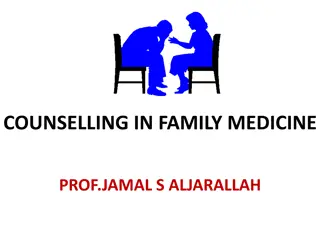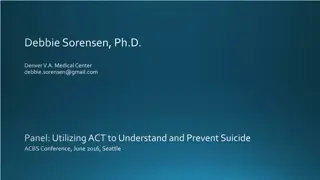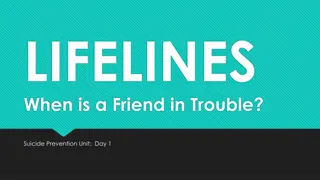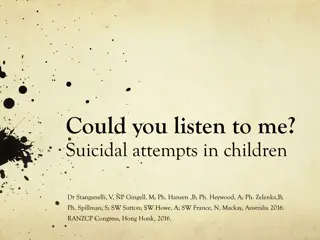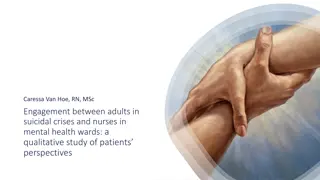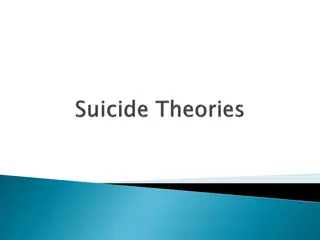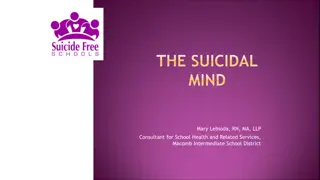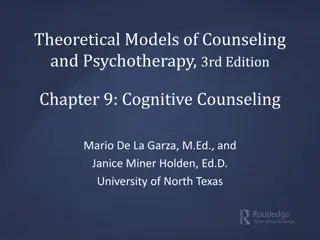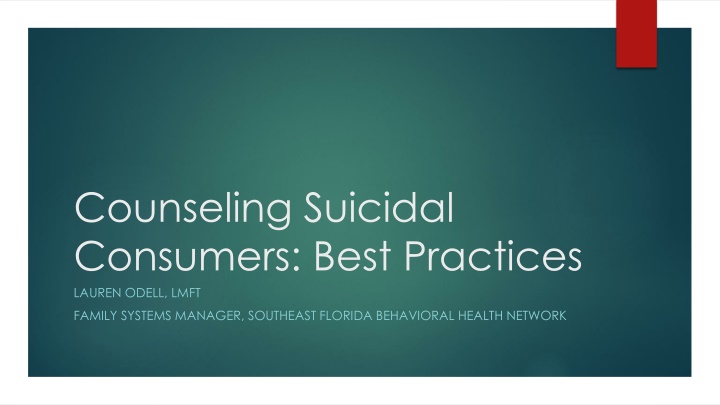
Supporting Suicidal Consumers: Best Practices and Treatment Considerations
Discover best practices for counseling suicidal individuals, including the importance of therapeutic relationships, monitoring treatment plans, and practicing self-care. Learn about cognitive-behavioral therapy, empowering consumers, and the significance of hope in treatment.
Download Presentation

Please find below an Image/Link to download the presentation.
The content on the website is provided AS IS for your information and personal use only. It may not be sold, licensed, or shared on other websites without obtaining consent from the author. If you encounter any issues during the download, it is possible that the publisher has removed the file from their server.
You are allowed to download the files provided on this website for personal or commercial use, subject to the condition that they are used lawfully. All files are the property of their respective owners.
The content on the website is provided AS IS for your information and personal use only. It may not be sold, licensed, or shared on other websites without obtaining consent from the author.
E N D
Presentation Transcript
Counseling Suicidal Consumers: Best Practices LAUREN ODELL, LMFT FAMILY SYSTEMS MANAGER, SOUTHEAST FLORIDA BEHAVIORAL HEALTH NETWORK
Treatment Considerations Research has shown intensity of suicidal intent is more highly correlated with hopelessness than with a diagnosis of depression Williams (et. al. 2005) concludes that the belief of hopelessness appears to be derived from the impaired cognitive functioning and distorted neurochemistry of a depressed person s mind. There are important factors in the treatment of suicidal individuals: Use of Cognitive-Behavioral Therapy to challenge distorted perceptions/thinking
Important factors in the treatment of suicidal individuals continued: Therapeutic Relationship: basics to consider State you are on their side, I am here for you. I am on your side Arrange furniture in a manner where no object separating you and the consumer Interruptions convey a lack of respect: create a distraction free zone Let the consumer pick their seat-depressed people often feel out of control Ask consumer, what would you like me to call you Talk openly about trust: has anyone in the past tried to help you? If yes, find out whether the help WAS actually helpful. Never finish a first session without finding a positive about the consumer- HOPE is important and it begins with the smallest steps
Monitoring the treatment plan Given that suicidal thoughts, planning and attempts are symptoms vs. diagnosis: it can be tempting to link with other symptoms of depression BEST PRACTICE is monitoring and tracking constantly. Asking the Suicide Question even if you believe the consumer to be making positive progress At times a relapse will occur and the suicidal person will not want to feel like a burden or sense of failure if thoughts arise. Therapist must assume responsibility and ask the question, follow up on subtle remarks, I'm just double checking because I care about you. Chart any positive or negative symptoms
Self Care is Important Therapist and helpers are not immune to the potential contagion of hopelessness Supervision Protocols are important If you are feeling anxious or inadequate as you prepare to meet a suicidal consumer, seek to understand and share with a colleague Expect to experience strong emotions during and after sessions If you find yourself feeling bored, seek immediate supervision! This will be noticed. If you feel anger, something has gone wrong with the therapy process. Keep your boundaries
Therapeutic Interventions Key Interventions: Empower the consumer: in picking the time of appointment; where they sit in the office; give permission to talk when they are ready; each day is a serious of choices Givens and Not Givens: Help consumers determine what is changeable and then what is not; consumer learns to think differently about their problems of daily life and learns to let go According to Us Department of Health and Human Services only three10 min periods of light exercise will significantly improve health. One day at a time: just need to make it through the next 24 hours HALT: hungry, angry, lonely, tired
Therapeutic Interventions continued.. Driving a wedge: separates the sufferer from the source of the pain. This process gradually leads to a better understanding of pain. Examples of wedges: when you feel the very worst, whose name or face comes to mind? It may open up the door to relationship counseling or identify who they person is in conflict with; or those they made be love with. What finally happened the last time you went through a period like this? Given all the things that heaven happened to you lately, can you really trust your thoughts? This is the way depressed people feel, when was the last time you didn't feel like this?
Interventions continued Bibliotherapy Choosing to Live: How to defeat suicide through Sundial through Cognitive therapy by Thomas Ellis and Cory Newman Suicide: The Forever Decision by Paul Quinnett Darkness Visible: A memoir of Madness by William Styron Night Falls Fast: Understanding Suicide
Interventions continued Make sure to keep blame and shame at a distance Keep contact face to face to manage and reframe negative thing Prepare for times of increased risk; ie holiday annivaries, holidays. The stronger the rapport the better work that WILL be done will?
RESOURCES Quinnett, Paul Counseling Suicidal People SAMHA http://www.suicidepreventionlifeline.org/ https://store.samhsa.gov/product/Preventing-Suicide-A-Toolkit-for-High- Schools/SMA12-4669 Questions or concerns feel free to SER FL LINC SPS SEFBHN Famitl System Manager for more information.



